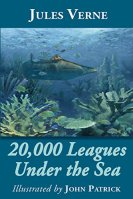
TAC Reviews...20,000 Leagues Under the Sea
Date Posted: 03/03/18
First published in its entirety in 1870 by French writer Jules Verne Vingt mille lieues sous les mers: Tour du monde sous-marin or Twenty Thousand Leagues Under the Seas: A Tour of the Underwater World is a classic science-fiction adventure novel. Similarly other stories from around that time that I have read, 20,000 Leagues…(I’m not going to write Under the Sea every time) was also serialised and ran from March 1869 through June 1870. Eventually the parts were put together into a novel. The final word in the title when written in French was “Seas” as in the “Seven Seas” whereas the English translation changed the word to Sea which meant the oceans generally.
Okay before I say anything else I’m going to point out that when I first started reading 20,000 Leagues Under the Sea I was under the impression that the titular 20,000 leagues was referring to the depth underwater when in fact it is distance travelled under the sea. This admittedly should have been a little obvious as 20,000 leagues is actually six times around the Earth and twice it’s circumference. In the novel the greatest depth that the Nautilus travels beneath the surface of the ocean is said to be four leagues which is approximately sixteen kilometres…which is impossible because the sea isn’t that deep but obviously in 1870 no one knew that...anyway let’s not get bogged down.
I have been waiting to read 20,000 Leagues Under the Sea for ages, but for one reason or another I was unable to get hold of a copy of it. Or more accurately a free copy of it for my Kindle, however, recently I was able to do just that so I eagerly started reading what I hoped would be another true classic of literature.
I’m not going to get too far ahead of myself so for those of you who don’t know, let me bring you up to speed on what is going on…
The year is 1866 and ships of several nations spot a mysterious sea monster roaming the oceans which some suggest to be a giant narwhal. The United States government assemble an expedition onboard the Abraham Lincoln to find and destroy the creature. Professor Pierre Aronnax, a French Marine Biologist (and the novel’s narrator) happens to be in New York at the time and is invited to join the expedition. An invitation he excepts. Aronnax brings with him Ned Land, a Canadian harpoonist, and Conseil, Aronnax’s faithful servant.
The Lincoln sets out on its journey and eventually ends up in the Pacific Ocean, where they come across the monster. After engaging the beast the Lincoln’s rudder is damaged, the creature emerges from the depths and a spray of water knocks Aronnax, Land and Conseil into the sea. The three grip the creature’s hide as the Lincoln sails away and climb onboard it only to discover that the monster is in fact a highly advanced submarine.
The three are brought onboard where they eventually meet the vessel’s creator, he introduces himself to them as Captain Nemo and they are now on his Nautilus. The three learn that the submarine was built in secret and now roams the seas without being bound by any land-based government.
Nemo tells the three that as he saved their lives they are welcome to join him on his explorations of the world’s oceans and seas, but as the only people who know the truth about the Nautilus are onboard the three can never leave.
The rest of the story charts the adventures of the Nautilus as it explores the riches of the oceans, and visits numerous sites, some real and others fictional (like the Lost City of Atlantis). Aronnax and Conseil are enthralled with the wonders of the oceans and the Nautilus itself but Ned Land can only think about escaping his confinement. Captain Nemo controls the fate of everyone onboard his ship and as time goes on the reason for his self-imposed exile under the waves leaves his guests in fear of their lives…
Considering how much I had built up this story in my mind it is probably unfair to say that it did not meet my expectations because I have to say that this novel was definitely ahead of its time.
In 1870 submarines were very primitive vessels and yet Verne manages to describe the sciences behind how such a submersible would work and none of it is beyond the realms of nineteenth century understanding. He does make you believe that such a ship could easily have been constructed if someone had the necessary time, money, manpower and scientific knowhow that Captain Nemo obviously does. The mystery of what the “monster” is also feeds into the idea of how little humans actually know about the oceans which cover almost seventy percent of the planet. The descriptions of the many under water wonders are also very impressive and you do honestly believe that if anyone could have found the Lost City of Atlantis it would have been Captain Nemo and his Nautilus.
But in the majority of pictures I have seen of the Nautilus most of them are of the infamous encounter the vessel has with a giant squid which in fact is a very small part of the novel. In the film Sphere (a film based on a novel by Michael Crichton) one of the characters talks about not being able to get past page 87 of 20,000 Leagues… in which the Aronnax and his friends are considering the possibility of a “formidable monster” (the giant squid) because it is too scary. However, in the novel moments later they encounter a group of giant squid that manage to kill one member of Nemo’s crew but are driven off without too much difficulty or further loss of life. Cannibalistic natives of one island attempt to board the Nautilus after it runs aground in a low tide at one point but an electrified outer-surface of the ship keeps them from getting onboard so there was really no threat from them either.
During the novel we learn that Captain Nemo exiled himself to the sea after an encounter with forces that occupied his country had a devastating effect on his family. His reasons for exploring the oceans seems to be both down to his scientific thirst for knowledge but also his desire for revenge upon civilisation. His character is more complex than that because there is an occasion when he defends an unknown diver from a shark and after he uses his Nautilus to take a terrible vengeance against a ship sobs in front of a picture of his family. He tries to avoid ships and doesn’t venture close to inhabited islands unless he absolutely has to, occasionally he allows Aronnax and Co to leave the Nautilus but only to venture on to islands that they have no hope of using to get back to civilisation.
Over the years I think I had built up a bit of a picture in my mind regarding what the novel was going to be about. In a live-action version that I think was the 1954 Disney film which I caught a bit of years ago, it seemed that Nemo was actively attacking ships in the open sea deliberately sinking them. At the time I don’t recall his reasons for doing this but I think he might have been targeting whaling vessels although I am not sure. Anyway, in the novel he only intentionally destroys a ship once. The reason the authorities think that a huge narwhal is the mysterious creature is because a hole that could have been because of the tusk on a narwhal’s head damaged a ship. The ship survived the encounter and again it is implied that the damage to the vessel was an accident rather than something Nemo did intentionally.
Taking away my own expectations I have to say that when the “monster” is being hunted by the Lincoln I was reading the book excitedly, once Aronnax and Co were taken onboard the Nautilus the novel slowed down considerably for me. I was awaiting the epic encounter with the giant squid, or to witness Nemo smashing whaling ships after appointing himself the protector of the seas, sadly I was left wanting in that regard.
I also think that the ending of the story is a little weak.
Ned Land spends a lot of the latter part of the book planning how he is going to escape his imprisonment onboard the Nautilus. He does not care about the scientific wonders of the oceans so he is eagerly awaiting any opportunity to be free of the ship. As the novel continued I was expecting him to attempt his escape with Aronnax and Conseil as the squid was attacking the ship. I thought that perhaps the novel would end with Nemo freeing Aronnax of his imprisonment and urging him and his friends to flee before the monster of the deep drags the Nautilus to the depths. Aronnax laments as he watches the Captain and his crew battle the squid as the submarine is pulled below the waves. He is left to wonder if the Captain and his wondrous vessel managed to get free on the monster’s tentacles and slay the beast. Aronnax believes that if anyone could have escaped their fate it would have been Captain Nemo and his Nautilus.
Sadly this doesn’t happen, after destroying the ship, Nemo goes a bit crackers and avoids further contact with Aronnax. The Nautilus becomes a ghost town and the vessel sails seemingly without anyone at the helm, and it wanders into a massive maelstrom (that’s whirlpool in case you don’t know). It is here that Ned Land decides to flee, Aronnax spots Nemo one more time as he prepares to take his chances with his friends, before being knocked unconscious and waking up back in civilisation.
Yep, that is really how it ends.
We don’t see the Nautilus being caught in the maelstrom or anything more of Nemo. By this time Aronnax has come to fear the Captain and nicknames him the “angel of hatred” so maybe Nemo was finally leading his ship to destruction. Maybe he had come to realise the monster he had become. Maybe he was just bored of roaming the seas so figured he might as well just send his wondrous machine to the crushing black abyss with himself onboard. I have no idea. I just think it was a bit of a shame that the final escape from the Nautilus wasn’t seen, although, the book does leave the fate of both Nemo and his ship unknown which I think is a good thing.
All in all I think that my issues with 20,000 Leagues Under the Sea were more to do with what I had been expecting based upon scraps of information from numerous sources over the years. I can appreciate the novel for creating both Captain Nemo and the Nautilus during a time when submarines were very basic craft. Plus the descriptions of the undersea world are incredibly detailed, even if they do get a little tedious after a while, but again I probably just thought that because I was waiting for the squid to attack already. I am going to read the novel again at some point because perhaps I will enjoy it more when I am not waiting for the infamous squid attack to happen or for Nemo to attack ships of the nations he has rejected.
I am going to give the novel a Thumbs Up, it is an incredibly piece of literature, and I can completely understand why this novel is a classic. It is a tremendous achievement which I would encourage others to sit down and read because it is worth reading. However, just be aware that this is not about battling giant sea monsters, or protecting the creatures of the oceans from the hand of man, it is a story about a man choosing to hide his pain and rage against civilisation beneath the waters of the sea.
7/10 – If I were to read the novel again I might chose to rate it higher because I am judging it based on what it is and not my expectations about what it should have been. That being said it is very description heavy which did start to get a little dull after a while because I was beginning to wonder if the giant squid was ever going to swim up and attack. Plus having Aronnax getting knocked out at the end and simply waking up back in civilisation was a bit of a cop out. It could have had a more satisfying ending if the battle with the squid had been the backdrop of Aronnax and Co’s escape.



